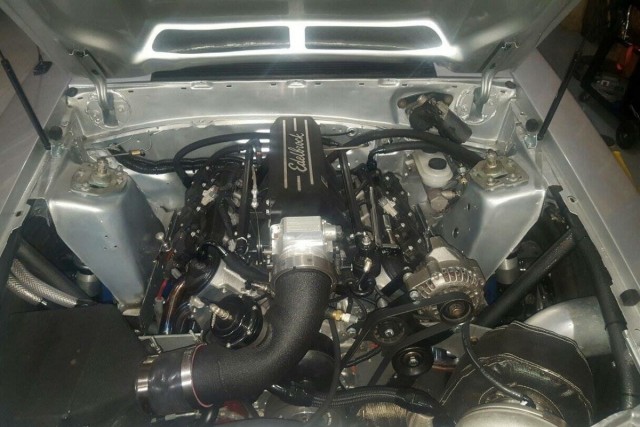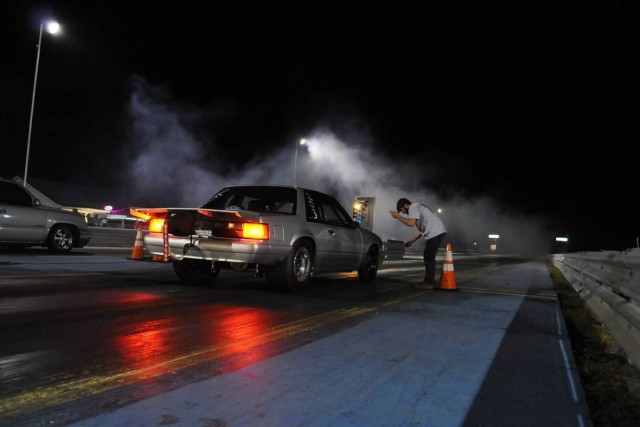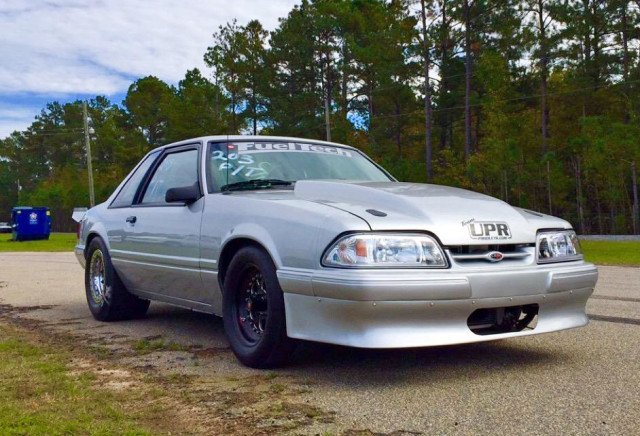Can we just go ahead and admit the Fox Mustang could be the greatest drag racing platform ever built? Inexpensive, plentiful, lightweight, and a monstrous aftermarket following means you can’t throw a rock at a drag race without hitting one – or many. At one time, we would say the Tri-Five Chevy, or 1967-’69 Camaros were the most popular, but prices on those cars have gone out of reach for most. For the Fox Mustang, the aforementioned characteristics have made the car super famous with the fast crowd.

Michael used a UPR Products K-member in the car, and it has a Fueltech FT500 EFI engine management system he uses to tune the combination. To deliver the fuel, the car relies on an Aeromotive belt drive fuel pump, a Magnafuel regulator, and Edelbrock fuel rails. To help maximize the turbocharger, the Fox boasts an air-to-water intercooler, a Leash Electronics Boost Leash Controller and Pulse Leash.
Savannah, Georgia’s Michael Bunton had a hopped-up diesel truck, in which he had invested tons of money to go against the grain. After he kept getting beat at the track by Fox Mustangs with far less money invested, Michael knew he had to switch it up. Plus, every time something broke on the truck, a $3,000 bill was soon to follow. Therefore, in the ultimate if-you-can’t-beat-‘em-join-‘em scenario, Michael went out and found him a 1993 Fox coupe of his own to build upon.
Pairing another inexpensive item with another, “I bought it as a project car with a stock LS1 in it,” Michael says. “It had a 4L60 in it,” he adds, “but I swapped it out for a Glide.” When he bought the car he went front to back to get the car track-ready. As soon as he deemed it good, and added upper and lower control arms, an anti-roll bar, and Competition Engineering 3-way adjustable rear shocks, he took it to the drag strip with a 150 shot and the ‘Glide.
“I went a 6.90 on the spray, and 6.90 on motor,” Michael says. Yes, you read that right, it went the same time on nitrous as it did without the nitrous. “That’s when I had to learn how to tune,” Michael says. “It was so rich that it wasn’t making any power,” he adds. With tuning, Michael was able to run 6.0s with a 175 shot.
Realizing he was really onto something, he decided to get safe and add a roll cage. “I bought an S&W 8-point roll cage, and installed it myself,” he says. However, after a nitrous system mishap, where Michael suffered burns to his side, he decided to go back to his power adder roots with a turbocharger.
After the nitrous mishap, and with a built bottom end, Michael added a Borg Warner S475 94 mm single turbo to the LS combination. When he bought the car, the engine had what was supposed to be a nitrous camshaft in it. He kept that cam in the engine, but upon further investigation, it wasn’t really a nitrous cam. However, even though the camshaft worked great on the street, at the track it wouldn’t build boost, making the engine very lazy.

The Fox coupe’s rear is mini-tubbed so Michael can run a Mickey Thompson 10.5W, or 275 Pro. Wheels are Holeshot, with 15×12 out back, and 15×4 up front. “My chassis guys are Matt Ryan and Daryl Waldrup. They built the coupe’s funny car-style cage,” Michael says. Out of all this, Michael started his own shop, MJB Performance, and he plans to race at Lights Out 7 at SGMP February 18th-21st. “My wife, Blaine, goes with me everywhere,” Michael says. Commando Racing helps Michael out, as well.
These days, the engine is an Abby’s Performance Engines-built, 388-inch combination utilizing an LSX block, K1 crank and rods, Wiseco pistons, a Brian Tooley Racing hydraulic roller cam, Trick Flow 245cc heads (massaged by Brian Tooley Racing), stock rockers, an Edelbrock Pro-Flow intake, a 92 mm throttle body, Bosch 240 injectors, stainless steel headers, and a 5-inch fender exit exhaust.
Behind the LSX is a Richard Disher-built Powerglide, which Michael paired with a PTC converter, a Hurst Quarter Stick shifter, and a Precision Shaft Technologies chromoly driveshaft. Out back, the 8.8 remains, with Strange Engineering 35-spline axles and spool, and Ford Racing 4.10 gears. The front and rear suspensions are both UPR Products, with the company’s Pro Extreme Duty upper and lower control arms and anti-roll bar. Menscher shocks replace the former Competition Engineering 3-ways, while Strange 10-way adjustable struts replace the car’s 90/10s. To bring the madness to a halt, Michael relies on Aerospace Components brakes at each corner.
This past weekend at Carolina Dragway (House of Hook), Michael blasted out to a 4.79 at 148 mph, with a 1.14 short time. That’s flat getting’ it done, son. “I built it to be competitive in street-type races,” Michael says. With the 4.79 in his pocket, we’d say he has accomplished his goal. And the best part of all — it’s a real, legitimate street car.


















